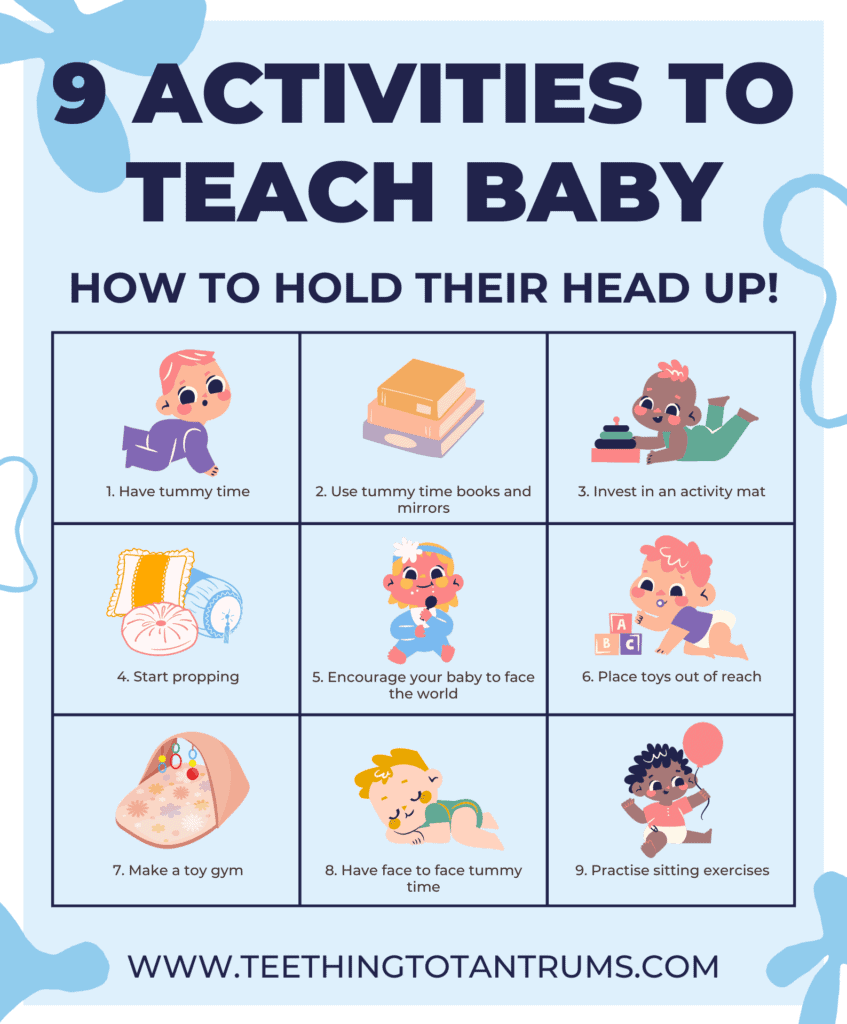A crucial gross motor milestone, asking “when can babies hold their head up?” is one of the first developmental leaps your baby will encounter.
In fact, your baby’s ability to hold up their head is the very first sign that they are moving towards learning to crawl and sit.
When Can Babies Hold Their Head Up?
Your baby will be able to hold their head at a 45-degree angle whilst on their tummy by 2 months old. And by 3-4 months your baby will regularly be pushing themselves up onto their elbows and holding their head at a 90-degree angle.
NOTE: Some babies will still need a bit of support around their head when moving from one position to another as their neck and upper body muscles are not quite developed enough to hold their head up independently all the time just yet (also known as head lag).
When Can Babies Hold Their Head Up On Their Own?
By 6 months of age, your baby should be able to hold their head up independently as they will have developed the muscles required to have full control of their neck and upper body.
In What Order Will Baby Develop Head Control?
Your baby’s ability to hold their head up independently will follow a specific order in their physical developmental journey.
And whilst every baby develops at their own rate, your baby’s head control development will go through certain stages as follows:
Stage 1: Newborn Head Control
Newborn babies have little to no head control.
Their neck and upper body muscles are not yet developed enough to hold their head unsupported, so you will need to take care in supporting their head for them all the time.
Stage 2: 1-2 Months Old
By one month of age, most babies will be showing signs of growing strength in their neck muscles and they will be able to hold their head up slightly when on their tummy.
By two months of age, babies will be able to hold their head up for slightly longer periods at a 45-degree angle.
However, you will still need to take care and support their head when they are in an upright position.
Stage 3: 3-4 Months Old
When your baby reaches the 3-4 month stage, they should be able to hold their head up at a 90-degree angle… especially when on their tummy and learning to push up onto their arms.
They may also be able to hold their head steady for short periods of time in an upright position too at this age…
Now is also the ideal time to start encouraging your baby to learn to sit too.
Stage 4: 5-6 Months Old
The previous months of slowly building up their neck and upper body muscles to support their head will now start to pay off as your baby moves towards sitting.
By this stage, your baby will be able to hold their head up with very little effort and turn their head from side to side and up and down with ease.
A bedtime & nap cheat sheet so good your little one will ask you to put them to bed...
Laura Williams "This is a life saver! I'm so glad I downloaded your bedtime & nap cheat sheet. My little one actually asked me to put him to bed last night! Unbelievable! Thank you so much!"
Click Here For The FREE Cheat Sheet
How Can We Help Baby Develop Head Control?
You can help your baby learn to hold their head up by providing age-appropriate play opportunities and activities to strengthen their neck and upper body muscles.

1. Tummy Time
We all know how important tummy time is for babies and for no greater reason than to ensure your little one can start to strengthen those all-important neck and upper body muscles in readiness for sitting and crawling.
Making sure your baby has regular tummy time in the early weeks and months is one of the best ways to help your baby learn to hold their heads up.
If your little one is struggling with tummy time, read my post Baby Hates Tummy Time to learn how to handle this tricky situation and find suitable alternatives.
2. Use Tummy Time Books And Mirrors
Making tummy time engaging is very important in ensuring your baby gets the most out of tummy time.
Using a tummy time book and/or floor mirror is a great way to encourage your baby to look forwards and upwards and as a result, start lifting their head independently.
We all know the importance of tummy time and there is no better way to keep your baby engaged during this essential activity than with a tummy time mirror. This one from Sassy is sturdy but soft and has a large good quality mirror that is guaranteed to grab baby's attention. It also comes in a black and white colourway.
3. Invest In An Activity Mat
An activity play mat encourages your baby to reach forwards and sideways which strengthens the upper body muscles that are necessary to support their head.
4. Start Propping
You can start propping your baby up during tummy time to encourage them to lift their upper body and head. A tummy time prop-up activity mat is ideal for aiding with this.
With this cushioned tummy time mat, your little one will have the cosiest space to support all their wiggles and kicks. Including a cute prop-up pillow, plush seal, baby-safe mirror and silk tags, this adorable mat will help every newborn love tummy time!
5. Encourage Your Baby To Face The World
Once your baby has some head control you can help them hold their heads up for longer periods by sitting them on your lap facing outwards and leaning back on you.
This allows your baby to get a good look at the world and practise holding their head up in a supported sitting position.
6. Place Toys Just Out Of Reach
Another great way to help your baby to hold their head up is to place toys just out of their reach when they are having tummy time.
Reaching for toys is fantastic for strengthening the upper body and neck muscles.
Use toys that are engaging sensually with contrasting colours, sounds and textures like this:
Babies love rattles and if you only buy one then this one is a great choice. This multisensory teething rattle has so much to offer in one package and I will guarantee that your little one will love exploring this great little toy.
7. Make A Toy Gym
Toy gyms are also good for strengthening the upper body. Place your baby under a play gym and let them bat away and reach for the dangling toys. I personally love this award-winning play gym from Lovevery:
This play gym is designed by experts for baby's developing brain and body. Winner of multiple awards it includes everything you need in an activity gym-from batting to teething to learning to focus-for a whole year of play.
8. Have Face To Face Tummy Time
A fun way to help your baby learn to lift their head up is to lay them face down on your tummy and have a face-to-face chat.
Your baby will have to lift their head to look at you and there’s nothing they will love more than to engage in some one-on-one time with you!
9. Practise Sitting Exercises
Once your baby has some basic head control you can start doing some pulling-to-sit exercises such as the one shown in this video by Pediatric Physical Therapy Exercises:
How To Hold Baby’s Head In The Meantime?
While your baby is learning to hold their head up independently, there are ways that you can help support their head in the meantime.
This involves holding them in certain positions that help build muscle control:
1. Cradle Their Head. When your baby is first born you will need to cradle their head as they will not be able to support their heads unaided. When you pick up your baby, slide a hand underneath your baby’s shoulder blade, supporting the neck and head while you place the other hand under their bottom. Do this in reverse when you put your baby down to ensure their head does not flop backwards.
2. Hold Them Upright. When you hold your baby over your shoulder keep a loose hold on their neck and head to stop any wobbling. As they get older, your baby may start to hold their head up while in this position for short periods of time but always have your hand ready for support.
3. Face Baby Outwards. Sitting your baby facing outwards with you as a support behind them is a great way to ensure your baby has plenty of back, neck and head support while safely allowing them to practice holding their head up.
4. Choose Strollers, Bouncers And Car Seats Carefully. When putting your young baby in any item where they have to be placed in a sitting position… Make sure that your baby has age-appropriate head support, that they are reclined adequately and that their head is well supported and does not flop forward.
What If Your Baby Can’t Hold Their Head Up Yet?
Your baby learning to hold their head up is a long and slow process that follows a sequence of developmental milestones…
But if you’re still concerned that your baby is not developing the strength to hold up their head, reach out to a medical professional or physical therapist for further advice.
Why Is My Baby’s Head Tilting To One Side?
Called congenital muscular torticollis (CMT), this condition is caused by a shortening of the muscle that bends and turns the head and neck resulting in a head that tilts to one side.
In most cases, CMT is successfully treated with physical therapy by a trained professional.
But there are plenty of gentle motion and strengthening exercises you can do at home to complement the physical therapy routine, along with general guidelines for holding and positioning the baby.
The Hospital for Specialist Surgery (HSS) has written a wonderful article explaining these exercises and positions in greater detail which you can read here.
Need More Parenting Help?
- Download our FREE Bedtime & Nap Sleep Cheat Sheet. It’s a free, easy-to-use and proven formula designed for parents of 0-5 year olds to master the art of consistently undisturbed and restful sleep without the yelling, nagging or exhausting long-winded evenings.
- Check out our Parenting Toolbox. You’ll get access to expertly-chosen products that you can guarantee are the best for your little one and your wallet.
- Are you looking for personalized guidance to navigate the challenges of parenting? I offer 1-on-1 consultations to bring you tailored strategies and actionable advice to help support your child's growth and well-being with confidence.

A bedtime & nap cheat sheet so good your little one will ask you to put them to bed...
Laura Williams "This is a life saver! I'm so glad I downloaded your bedtime & nap cheat sheet. My little one actually asked me to put him to bed last night! Unbelievable! Thank you so much!"
Click Here For The FREE Cheat Sheet






